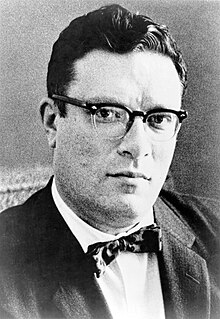Our website is made possible by displaying online advertisements to our visitors.
Please consider supporting us by disabling your ad blocker.
Isaac Asimov
Isaac Asimov | |
|---|---|
 Photo circa 1959 | |
| Native name | |
| Born | c. January 2, 1920[a] Petrovichi, Russian SFSR |
| Died | April 6, 1992 (aged 72) New York City, U.S. |
| Occupation | Writer, professor of biochemistry |
| Nationality | American |
| Education | Columbia University (BS, MA, PhD) |
| Genre | Science fiction (hard SF, social SF), mystery, popular science |
| Subject | Popular science, science textbooks, essays, history, literary criticism |
| Literary movement | Golden Age of Science Fiction |
| Years active | 1939–1992 |
| Spouse |
|
| Children | 2 |
| Relatives |
|
| Signature | |
 | |
| Scientific career | |
| Fields | Biochemistry |
| Institutions | Boston University |
| Thesis | The kinetics of the reaction inactivation of tyrosinase during its catalysis of the aerobic oxidation of catechol (1948) |
| Doctoral advisor | Charles Reginald Dawson |
| Other academic advisors | Robert Elderfield (post-doctoral) |
Isaac Asimov (/ˈæzɪmɒv/ AZ-ih-mov;[b] c. January 2, 1920[a] – April 6, 1992) was an American writer and professor of biochemistry at Boston University. During his lifetime, Asimov was considered one of the "Big Three" science fiction writers, along with Robert A. Heinlein and Arthur C. Clarke.[2] A prolific writer, he wrote or edited more than 500 books. He also wrote an estimated 90,000 letters and postcards.[c] Best known for his hard science fiction, Asimov also wrote mysteries and fantasy, as well as popular science and other non-fiction.
Asimov's most famous work is the Foundation series,[3] the first three books of which won the one-time Hugo Award for "Best All-Time Series" in 1966.[4] His other major series are the Galactic Empire series and the Robot series. The Galactic Empire novels are set in the much earlier history of the same fictional universe as the Foundation series. Later, with Foundation and Earth (1986), he linked this distant future to the Robot series, creating a unified "future history" for his works.[5] He also wrote more than 380 short stories, including the social science fiction novelette "Nightfall", which in 1964 was voted the best short science fiction story of all time by the Science Fiction Writers of America. Asimov wrote the Lucky Starr series of juvenile science-fiction novels using the pen name Paul French.[6]
Most of his popular science books explain concepts in a historical way, going as far back as possible to a time when the science in question was at its simplest stage. Examples include Guide to Science, the three-volume Understanding Physics, and Asimov's Chronology of Science and Discovery. He wrote on numerous other scientific and non-scientific topics, such as chemistry, astronomy, mathematics, history, biblical exegesis, and literary criticism.
He was the president of the American Humanist Association.[7] Several entities have been named in his honor, including the asteroid (5020) Asimov,[8] a crater on Mars,[9][10] a Brooklyn elementary school,[11] Honda's humanoid robot ASIMO,[12] and four literary awards.
- ^ a b Cite error: The named reference
azimovwas invoked but never defined (see the help page). - ^ Freedman, Carl (2000). Critical Theory and Science Fiction. Doubleday. p. 71. ISBN 9780819563996.
- ^ "Isaac Asimov Biography and List of Works". Biblio.com. Archived from the original on July 30, 2010. Retrieved March 5, 2008.
- ^ "1966 Hugo Awards". thehugoawards.org. Hugo Award. July 26, 2007. Archived from the original on May 7, 2011. Retrieved July 28, 2017.
- ^ Asimov, Isaac (1994). I. Asimov: A Memoir. New York: Doubleday. pp. 475–476. ISBN 0-385-41701-2.
- ^ Asimov, Isaac (1969). Opus 100. Houghton Mifflin Harcourt.
So [Walter Bradbury] said, 'Use a pseudonym.' And I did. I chose Paul French ...
- ^ Asimov, Isaac (1994). I. Asimov: A Memoir. New York: Doubleday. p. 500. ISBN 0-385-41701-2.
- ^ "5020 Asimov". Minor Planet Center. Archived from the original on February 25, 2021. Retrieved October 22, 2017.
- ^ "USGS Gazetteer of Planetary Nomenclature, Mars: Asimov". Archived from the original on February 24, 2021. Retrieved September 4, 2012.
- ^ Edgett, Ken (May 27, 2009). "The Martian Craters Asimov and Danielson". The Planetary Society. Archived from the original on November 7, 2017. Retrieved November 6, 2017.
- ^ "P.S. 099 Isaac Asimov" Archived August 6, 2018, at the Wayback Machine at New York City Department of Education website. (Retrieved August 6, 2018.)
- ^ Kupperberg, Paul (2007). Careers in robotics. New York: Rosen Pub. p. 8. ISBN 978-1-4042-0956-5.
Cite error: There are <ref group=lower-alpha> tags or {{efn}} templates on this page, but the references will not show without a {{reflist|group=lower-alpha}} template or {{notelist}} template (see the help page).
Previous Page Next Page


